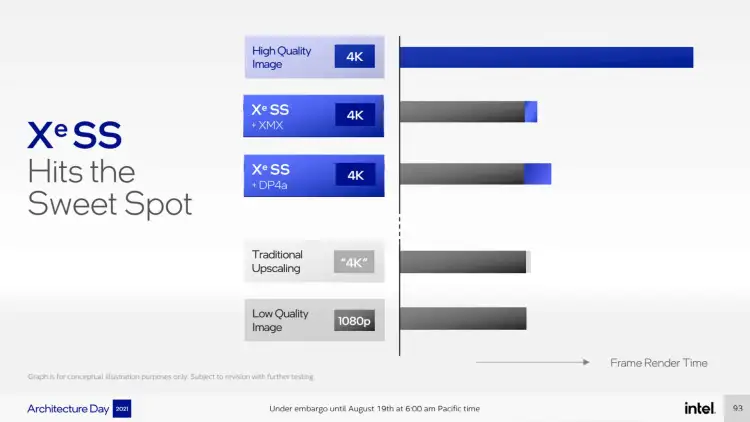Intel held its Architecture Day 2021 on August 19 to show off plenty of the exciting things it’s been cooking up for years now. And it’s about time, as the last few years have been pretty slim pickings depending on who you ask. For us gamers, that has been the case. This year was pretty stacked, though. Aside from the long-awaited reveal of Alder Lake and its new GPU architecture for graphics cards, Intel also showcased its XeSS AI-based upscaling technology. Another potential competitor to Nvidia’s DLSS, no less.
There’s a lot to get excited about for this announcement, if not simply for the fact that it shows Intel’s serious commitment to high performance 3D rendering. Of course, high performance rendering is costly unless you know the right tricks to get more out of the hardware. Nvidia does exactly that with its DLSS technology that takes lower resolution images and uses AI to upscale it to higher quality images without the performance hits of native rendering. AMD’s FidelityFX Super Resolution (FSR) tech takes a similar approach in terms of the final visual result, but the implementation behind AMD’s technique is far less complex.
Until now, Nvidia has been the only company using AI deep learning to perform upscaling for games. Based upon personal experience, the results from the Green tech are more impressive overall. However, as many developers have noted, it’s more difficult to work with. Part of that likely has to do with how Nvidia manages it. AMD treats FSR as open source, making it far easier for developers to understand and implement. We now know that Intel will also take a page out of AMD’s book for XeSS. It too will be open source, albeit with the caveat that it will only happen once it “reaches maturity.”
Best of all, any modern GPUs will apparently be able to use XeSS, though Intel claims the rendering times will be better on ARC GPUs due to some optimizations. At any rate, the end result will still be a clear improvement over native rendering.

The promise of Intel’s fancy new image upscaling tech is that it will provide low render times without sacrificing on image quality. It will also give older GPUs new life.
XeSS is looking good, Intel
Intel didn’t just talk tough today, though. It provided some actual examples of XeSS in action, along with side-by-side comparisons. The environments were created in Unreal Engine, which is a promising detail in itself. The footage in the video showcases how Intel XeSS is able to upscale from a base resolution of 1080p to recreate images in 4K. From what we can tell, the results are just as good as Nvidia’s finest. However, Intel claims its tech only needs 1080p rendering to work great.
It remains to be seen if there will be quality options like with FSR and DLSS, and we will have to be the judges of how well the tech works outside of Intel’s cherrypicked examples. From what we’ve seen today, things do look promising though.
Intel didn’t mention any specific games that will support XeSS, but it did confirm it’s working with several developers. Those details will only become known with time. The first generation of Intel graphics cards will launch in Q1 of 2022, and this tech will presumably come alongside it. We’re sure to learn much more leading up to launch.







Published: Aug 19, 2021 04:30 pm